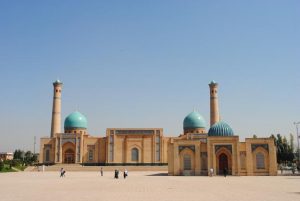Influenced by diverse cultures that in the long history have been brought here by various nations conquering Central Asia, the national Uzbek cuisine has formed into a unique oriental cuisine.
The basic ingredients of Uzbek dishes are flour, meat (usually mutton), fat of a sheep’s tail, vegetables, herbs and spices, and, in almost all food, a considerable amount of oil of different sorts – that of cottonseed, sesame or sunflower, which make Uzbek food highly nourishing and rich in calories. Pork is never used in the Uzbek cuisine. Some of the Uzbek dishes are cooked only by men, while others exclusively by women. The cooking of some special dishes is connected with particular holidays and festivals, important events and beliefs.
Uzbekistan’s signature dish is palov (also spelled pilaff, plov, pilau, pilav, polow, pulaw, pulao, osh), typically made with rice, meat, grated carrots, onions and special spices.
Herbs and spices, such as coriander, zira (zra, kumin), barberries, sesame, basil (raihon), and others, are special features of Uzbek food, some of them whetting your appetite, and others having curative effect. Katik (sour milk, classic yogurt, also spelled katyk, qatiq, qatyq) is also a common ingredient in Uzbek food, together with the summer radish, which is not so pungent as the black radish, and even sweet if cooked with carrot in oil.
The dishes of the Uzbek cuisine are often cooked with the use of special devices and kitchen utensils:
– kaskan (steamer). Some of the Uzbek dishes, such as manty and khanuma (other notable uzbek national dishes), acquire their original taste only if steamed in a special pot – kaskan with removable grids;
– tandir oven (also spelled tandyr, tandoor), a Central Asian clay oven. Tandir is handmade and has the form of a huge clay jug, placed vertically or horizontally. Horizontal tandirs are used for baking traditional Uzbek bread, while vertical ones are more suitable for samsa pasties (also spelled somsa, samosa, samoosa);
– kazan, a cast-iron cauldron with thick walls. There are a number of Uzbek dishes that can be cooked only in a kazan over an open fire, for it retains heat well and distributes it evenly.
The national tableware, in which food is traditionally served, includes:
– kosa eating bowl (also spelled kasa, kese, qosa, qasa). Usually used for shurpa – a delicious soup made of meat and vegetables; lagman and norin, noodle-based dishes;
– lagan, a large dish decorated with traditional painting for serving pilaf, manty, dimlama (a meat and vegetable stew) and various kebabs;
– piala, a small kosa for tea – green tea is the national hot beverage taken throughout the day.
In Uzbekistan traditionally teahouses (chaikhanas) are very popular and have a cultural importance. Green or black tea always accompanies a meal and is typically taken without milk or sugar. Tea and oriental sweets are automatically offered to every guest as a symbol of hospitality.
Traditionally Uzbeks have meals on the floor or, in summertime, on a topchan (a large wooden bed of a particular shape), on which they put a short-legged table and cover it with a dastarhan (tablecloth); very often they manage without the table, simply spreading the dastarhan on the floor or on a topchan. Around the dastarhan they put colourful kurpachas (kurpacha is a traditional Central Asian thick cotton-wool blanket / mattress) and small cushions, so that guests can have a little rest after a nourishing dinner.
However, it is not only the natural, fresh and salutary ingredients, special kitchen utensils or traditional ways of having a meal that makes the Uzbek cuisine so original and attractive, but the famous, infinite Central Asian hospitality!
Welcome!

